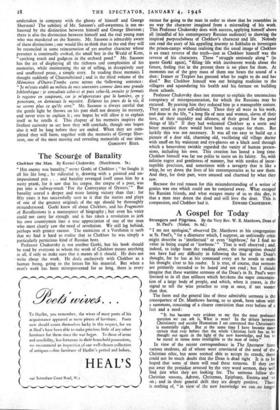Ghosts
Siegfried's Journey. By Siegfried Sassoon. (Faber and Faber. 10s. 6d.)
IN a famous trilogy, Mr. Sassoon has recorded the experiences of George Sherston before and during the war of 1914-1918.. In this book Mr. Sassoon continues his own reminiscences ; but they are so bound up with those of George Sherston that Siegfried's Journey only begins where Sherston's Progress left off. George Sherston was largely a work of art, and perhaps he died when he had served his purpose. Mr. Sassoon, fortunately, still lives, and he is still remembering, still pondering the paradoxes of his character, still trying to come to grips with the process by which a foxhunter, cricketer and war hero became a socialist and pacifist and both became a poet. Here he describes his experiences from 1916-192o ; very largely he is concerned with memories of a social, literary and political life which could not be shared with George Sherston. He describes the growth of his literary reputation; his social and intellectual friendships, electioneering for Philip Snowden, collaboration on the old Daily Herald, a lecture tour in America-; and at the back of his mind is always a sense of surprise that these experiences should have happened to him. The list of his friends and acquaintances includes Ottoline Morell, Robert Ross, Wilfred Owen, Osbert Sitwell, Robert Bridges ; of each he gives a vivid picture, but the most moving of these reminiscences of friendship are inspired by Thomas Hardy and Wilfred Scawen Blunt in their old age, perhaps because their integrity and self-sufficiency contrast so sharply with his own youthful uncertainties and self-contradictions. Hardy, especially, is offered as a. kind of touchstone of what is false and what is true in the impressions that crowded so thickly upon his young friend.
Mr. Sassoon is inclined to discover more of the false than the true in these impressions ; only he regards them with a certain deprecating affection for his own youth, which he struggles to recapture. At the end of the book he confesses that he has only half succeeded. Looking back, at himself, " picturing him in the clear afternoon light, in his New York straw hat, with the National Gallery in the background, I can almost believe that I am looking back at .a faded photograph." Elsewhere he has expressd the same Jetachment: " Degrees of groping thought have taught me to conclude That when a man began in youth to learn truth crude From life in the demented strife and ghastly glooms
Of soul-conscripting war, mechanic and volcanic,—
Not much remains, twelve winters later, of the hate Of purgatorial pains."
Mr. Sassoon is always asking himself what happened to that young man, and the question gives his memories a depth and signi- ficance they would otherwise lack. The reader asks the same
question slightly differently. What has become of the young man? What processes of change did he still have to undergo before h: could look back on himself with such gentle irony? And what in the end will be the result of this odd journey Mr. Sassoon has undertaken in company with the ghosts of himself and George Sherston? The subtlety of Mr. Sassoon's .self-awareness is not ex- hausted by the distinction between himself and George Sherston ; there is also the distinction between himself and the real young man who was murdered on the Somme. Mr. Sassoon is admirably aware of these distinctions ; one would like to think that in the end they will be reconciled in some reincarnation of yet another character whose presence is continually evoked, the small boy in the Weald of Kent, " catching roach and gudgeon in the orchard pond." Mr. Sassoon has the art of displaying all the richness and complexities of his memories, while maintaining the air of telling, in deceptively easy and unaffected prose, a simple story. In reading these memoirs I thought suddenly of Chateaubriand ; and in the third volume of the Memoires d'Outre-Tombe came across the 'following sentence: " 7e m'etais etabli au milieu de mes souvenirs comme dans une grande bibliotheque : je consultais celui-ci et puis celui-la, ensuite je fermais le registre en soupirant, car je m'apercevais que la lumiere, en y penetrant, en detruisait le mystery. Eclairez les fours de la vie, it rte seront plus ce qu'ils sort." Mr. Sassoon is always careful that the gentle light he throws on his past shall not destroy its mystery, and never tries to explain it ; one hopes he will allow it to explain itself as he retells it. This chapter of his memoirs inspires the liveliest curiosity to see how they will conclude, though one hopes also it will be long before they are ended. When they are com- pleted they will form, together with the memoirs of George Sher- ston, one of the most moving and revealing memorials of our time.
GORONWY REES.
































 Previous page
Previous page